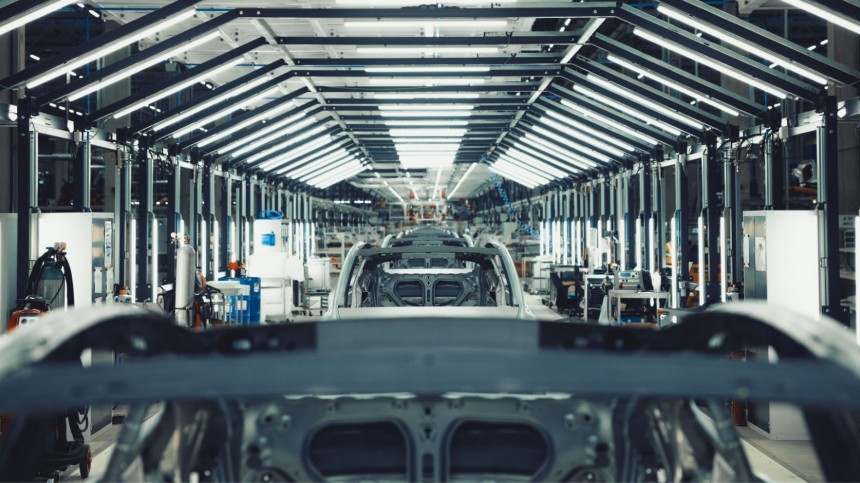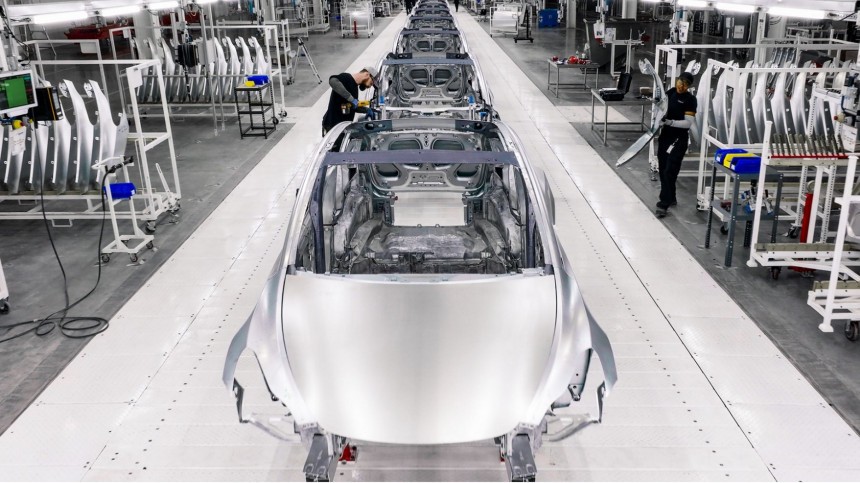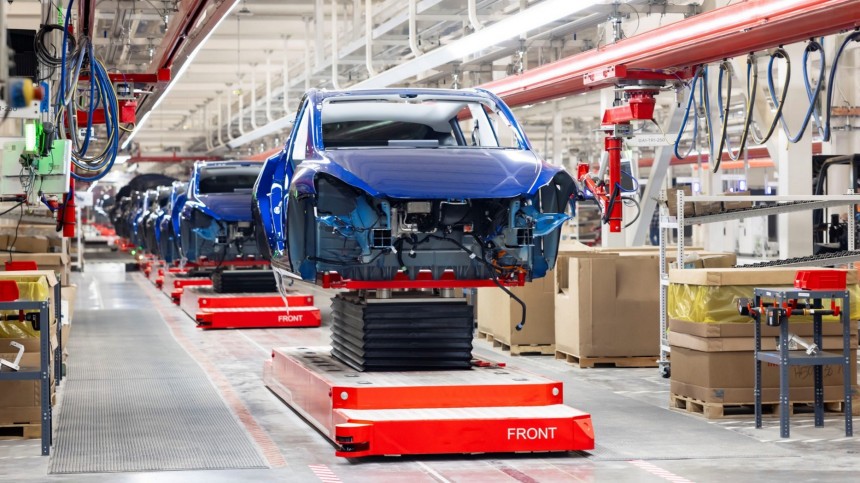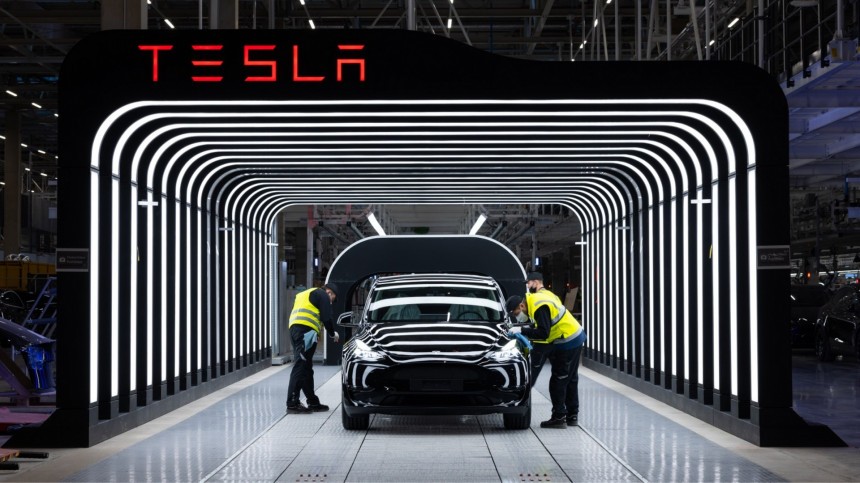One of the explanations Tesla advocates find to justify why the company is cutting prices is that the company was allegedly so efficient in slashing costs that it now can share that with customers. The goal would be to "save the world" by making battery electric vehicles (BEVs) more affordable. I've already discussed how the effect can be right the opposite and how no car will ever save the planet. Anyway, this story is the second part in a series about Tesla profits, so let's stick to understanding them and examining the first excuse for the discounts.
Tesla had never shared how much it spends to build a car until the Q3 2023 earnings report. With it, the BEV maker finally shed some light on the subject, even if not that much. The company said that its cost of goods sold (COGS) per vehicle decreased to around $37,500. At the bottom of the document, Tesla clarified it calculated this expense "by dividing Cost of Automotive Sales Revenue (CASR) by respective quarter's new deliveries."
These are the words the company uses to define CASR in its Forms 10-Q, submitted to the US Securities and Exchange Commission (SEC):
"Cost of automotive sales revenue includes direct parts, material and labor costs, manufacturing overhead, including depreciation costs of tooling and machinery, shipping and logistics costs, vehicle connectivity costs, allocations of electricity and infrastructure costs related to our Supercharger network, and reserves for estimated warranty expenses. Cost of automotive sales revenues also includes adjustments to warranty expense and charges to write down the carrying value of our inventory when it exceeds its estimated net realizable value and to provide for obsolete and on-hand inventory in excess of forecasted demand."
If that is how Tesla calculates COGS, we can do the same in all quarters. As the first one I found was from Q3 2019, it seemed like a good idea to use it as my first example. At the time, the BEV maker delivered 17,483 units of the Model S and Model X, but 2,588 were leased. Tesla also works with a cost of automotive leasing revenue – which follows different account rules – so we must exclude leased vehicles from the total.
The company delivered 79,703 Model 3s, but 6,498 were leased – the Model Y would reach production lines months later. Add the resulting 14,895 Model S and Model X units and 73,205 Model 3s, and you get 88,100 BEVs. With a cost of automotive sales revenue of $4.014 billion, dividing it by 88,100 cars will tell us the BEV maker spent $45,561.86 to make each car it sold in that quarter. Interesting, right? Let's fast forward to Q3 2022 to check how these cost-cutting measures worked in a year compared to production expenses.
In that quarter, Tesla delivered a total of 343,830 units, of which 11,004 were subject to operating leasing accounting. That leaves us with 332,826 BEVs. As the CASR was $13.099 billion, COGS was $39,356.90 per car, with an alleged profit per unit of $9,574.50.
If you check the Q2 2022 numbers, both the cost of automotive sales revenue and the COGS were higher, respectively, at $13.67 billion and $55,690. How have they dropped so sharply in Q3 2022, particularly with the ramp-up expenses of two new factories? Although Tesla delivered more cars in Q3 2022, the higher production costs for the Model 3 and Model Y mentioned in the respective Form 10-Q only seem to appear in the Q4 2022 results, with the lower net income per BEV of $9,097.46. As mentioned in my previous story on Tesla profits, discounts only kicked off in January 2023.
In Q4 2022, the cost of automotive sales revenue was $11.916 billion for 390,094 BEVs (already ignoring the leased vehicles), which leads to a COGS of $30,546.48 per car. Again, another miraculous reduction, this time from the $39,356.90 per car that we saw in Q3 2022. Yet, it did not make profits rise by $8,810.42. On the contrary: as I already wrote, the earnings per BEV dropped, which sounds pretty weird with such a cost reduction. To be honest, the alleged expense decrease seems contradictory with the "rising raw material, logistics and warranty costs." Tesla advocates will say the company's engineering prowess explains everything. It doesn't – and the alleged mastery is denied by the frequent defects these cars present.
That surprising COGS did not last for long. In Q1 2023, the CASR was $15.422 billion for 400,518 BEVs delivered, which represents a cost of goods sold of $38,505.14 per BEV. On top of the discounts – which were then $14,400 on average compared to 2022 prices – you also have a cost increase of $7,958.65 from one quarter to the other. Tesla's $5,942.65 profits per car should have vanished – unless the company wants us to believe they would be above what Nikkei Asia calculated for Q3 2022.
In Q2 2023, the cost of automotive sales revenue was $16.841 billion. Tesla said it delivered 466,140 cars, of which 21,883 were leased. Exclude them, and you have 444,257 BEVs, a number that leads us to a COGS of $37,908. According to it, the company saved $596,90 per car in that quarter compared to the previous one, but the average price cuts were then at $16,950, or $2,550 higher than in Q1 2023 – when they already didn't make any sense.
We still do not have the Form 10-Q for Q3 2023, but Tesla shared the data in the Q3 2023 earnings report. The company's CASR was $15.656 billion, and it delivered 435,059 vehicles, of which 17,423 were leased. The number of BEVs to calculate the cost of goods sold is 417,636, which gives us a figure that is slightly lower than the $37,500 Tesla talked about: it is $37,487.19. The difference between the Q2 2023 and Q3 2023 is $421.05. The average discount at this point was $23,850.
If we compare the Q3 2023 COGS to the one in Q3 2022, the savings are $1,856.90 per unit. However, they were not always constant. Making these savings talk demanded more calculations, even if they were quite simple. We just have to multiply the COGS differences by the cars delivered by Tesla in each quarter.
The $8,810.42 savings in Q4 2022, multiplied by the 405,278 BEVs delivered in that quarter, represent an amount of $3,570,668,397.99. Mind you that I am not even removing the leased cars. That would be a fantastic achievement if it were not for the following quarter – when the COGS difference from Q1 2023 to Q4 2022 was -$7,958.65. That times 422,875 BEVs represents a loss: -$3,365,515,041.06, which almost makes the previous seeming savings disappear.
Multiply the difference between Q4 2023 and Q1 2023 ($596,90 per car) by the total 466,140 BEVs the company handed to clients in Q2 2023; the result will be $278,238,056.93. Compared to the $3.57 billion from Q4 2022, the number will look poor. And it is, but not as low as the following savings.
Tesla delivered 435,059 BEVs in Q3 2023, which, times the $421.05 difference between Q3 2023 and Q2 2023, turns into $183,180,720.81. Sum up all these savings with the loss in Q1 2023, and the result is $666,572,134.67. In other words, the $666 million is not even 10% of all the money Tesla willingly decided not to earn with the discounts that started in January 2023. If you read the first story of this series, you know the minimum losses amount to $7.77 billion, so the production cost savings represent only 8.6% of the least amount of money Tesla lost with the price cuts.
This proves production cost cuts – as impressive as they may have been – do not justify the discounts. It is time to check the second hypothesis for Tesla to explain them: the Energy and Services divisions doing better than ever.
These are the words the company uses to define CASR in its Forms 10-Q, submitted to the US Securities and Exchange Commission (SEC):
"Cost of automotive sales revenue includes direct parts, material and labor costs, manufacturing overhead, including depreciation costs of tooling and machinery, shipping and logistics costs, vehicle connectivity costs, allocations of electricity and infrastructure costs related to our Supercharger network, and reserves for estimated warranty expenses. Cost of automotive sales revenues also includes adjustments to warranty expense and charges to write down the carrying value of our inventory when it exceeds its estimated net realizable value and to provide for obsolete and on-hand inventory in excess of forecasted demand."
The company delivered 79,703 Model 3s, but 6,498 were leased – the Model Y would reach production lines months later. Add the resulting 14,895 Model S and Model X units and 73,205 Model 3s, and you get 88,100 BEVs. With a cost of automotive sales revenue of $4.014 billion, dividing it by 88,100 cars will tell us the BEV maker spent $45,561.86 to make each car it sold in that quarter. Interesting, right? Let's fast forward to Q3 2022 to check how these cost-cutting measures worked in a year compared to production expenses.
In that quarter, Tesla delivered a total of 343,830 units, of which 11,004 were subject to operating leasing accounting. That leaves us with 332,826 BEVs. As the CASR was $13.099 billion, COGS was $39,356.90 per car, with an alleged profit per unit of $9,574.50.
In Q4 2022, the cost of automotive sales revenue was $11.916 billion for 390,094 BEVs (already ignoring the leased vehicles), which leads to a COGS of $30,546.48 per car. Again, another miraculous reduction, this time from the $39,356.90 per car that we saw in Q3 2022. Yet, it did not make profits rise by $8,810.42. On the contrary: as I already wrote, the earnings per BEV dropped, which sounds pretty weird with such a cost reduction. To be honest, the alleged expense decrease seems contradictory with the "rising raw material, logistics and warranty costs." Tesla advocates will say the company's engineering prowess explains everything. It doesn't – and the alleged mastery is denied by the frequent defects these cars present.
That surprising COGS did not last for long. In Q1 2023, the CASR was $15.422 billion for 400,518 BEVs delivered, which represents a cost of goods sold of $38,505.14 per BEV. On top of the discounts – which were then $14,400 on average compared to 2022 prices – you also have a cost increase of $7,958.65 from one quarter to the other. Tesla's $5,942.65 profits per car should have vanished – unless the company wants us to believe they would be above what Nikkei Asia calculated for Q3 2022.
We still do not have the Form 10-Q for Q3 2023, but Tesla shared the data in the Q3 2023 earnings report. The company's CASR was $15.656 billion, and it delivered 435,059 vehicles, of which 17,423 were leased. The number of BEVs to calculate the cost of goods sold is 417,636, which gives us a figure that is slightly lower than the $37,500 Tesla talked about: it is $37,487.19. The difference between the Q2 2023 and Q3 2023 is $421.05. The average discount at this point was $23,850.
If we compare the Q3 2023 COGS to the one in Q3 2022, the savings are $1,856.90 per unit. However, they were not always constant. Making these savings talk demanded more calculations, even if they were quite simple. We just have to multiply the COGS differences by the cars delivered by Tesla in each quarter.
Multiply the difference between Q4 2023 and Q1 2023 ($596,90 per car) by the total 466,140 BEVs the company handed to clients in Q2 2023; the result will be $278,238,056.93. Compared to the $3.57 billion from Q4 2022, the number will look poor. And it is, but not as low as the following savings.
Tesla delivered 435,059 BEVs in Q3 2023, which, times the $421.05 difference between Q3 2023 and Q2 2023, turns into $183,180,720.81. Sum up all these savings with the loss in Q1 2023, and the result is $666,572,134.67. In other words, the $666 million is not even 10% of all the money Tesla willingly decided not to earn with the discounts that started in January 2023. If you read the first story of this series, you know the minimum losses amount to $7.77 billion, so the production cost savings represent only 8.6% of the least amount of money Tesla lost with the price cuts.
This proves production cost cuts – as impressive as they may have been – do not justify the discounts. It is time to check the second hypothesis for Tesla to explain them: the Energy and Services divisions doing better than ever.





























